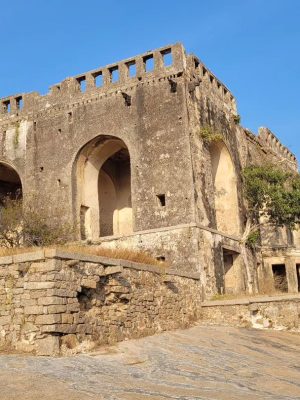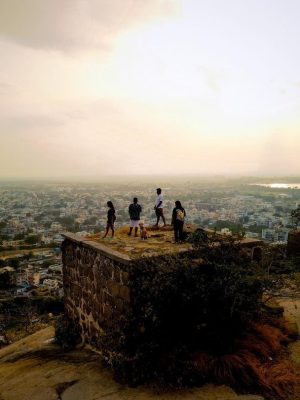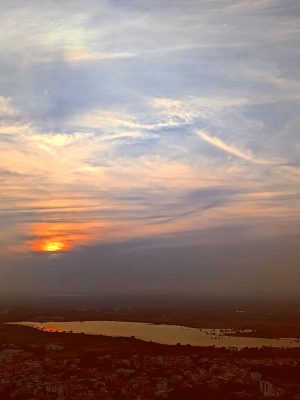- Home
- Telangana
- Bhuvanagari Fort
Discover the Untold Stories of Bhuvanagari Fort: An Epic Journey Awaits!
Things to do in Bangalore

Trekking

Night Trek

Camping

Parties

One Day Trips

Two Days Trip

Adventure

Workshop

Trekking

Camping

One & Two Day Trips

Adventure & Parties
Experiences Near Bangalore
Unveiling Bhuvanagiri Fort's Rich Historical Significance
Perched atop a rugged hill in the Indian state of Telangana lies the ancient Bhuvanagiri Fort, a majestic citadel that has stood witness to centuries of history and legend. With its towering ramparts, intricate architecture, and panoramic views of the surrounding landscape, this formidable fortress beckons adventurers and history enthusiasts to uncover its secrets. From tales of royal conquests to whispers of hidden treasures, Bhuvanagiri Fort is steeped in intrigue and allure, offering a glimpse into a bygone era that continues to captivate modern-day explorers.
As you stand at the foot of this imposing structure, it’s hard not to be drawn in by the air of mystery that shrouds Bhuvanagiri Fort. The echoes of ancient battles reverberate through its weathered walls, while the timeless beauty of its design speaks volumes about the skill and craftsmanship of those who built it. Whether you’re an avid historian or simply an adventurous soul with a thirst for discovery, delving into the history and legends surrounding Bhuvanagiri Fort promises an unforgettable journey through time and culture. Join us as we explore this splendid citadel, unearthing stories that have been etched into its very stones for generations.
Introduction: Unveiling Bhuvanagiri Fort's Rich Historical Significance
Nestled amidst the scenic landscapes of Telangana, Bhuvanagiri Fort stands as a silent sentinel, bearing witness to centuries of history and heritage. This impressive fortress, commanding the hilltop above Bhongir, invites travelers and history enthusiasts to delve into its rich past and uncover the secrets concealed within its ancient walls.
Exploring the Legacy
Bhuvanagiri Fort, also known as Bhongir Fort, boasts a history that dates back to the 10th century when it was constructed by the Western Chalukya ruler Tribhuvanamalla Vikramaditya VI. Over the centuries, it passed through the hands of various dynasties, including the Kakatiyas, Bahmanis, and Qutb Shahis, each leaving their mark on its sprawling complex.
Architectural Marvels
The fort’s architectural marvels stand as a testament to the ingenuity of its builders. Spanning a vast expanse, the fort encompasses a succession of gateways, ramparts, and bastions, showcasing a fusion of Hindu and Islamic architectural styles. Perched atop a rocky hill, its strategic positioning rendered it impregnable, earning it the “Gibraltar of the East.”
Historical Significance
Bhuvanagiri Fort played a significant role in shaping the region’s history and witnessed several pivotal events. It served as a military stronghold, commanding control over the surrounding territories and safeguarding against invasions. It became a center of power and governance during the medieval period, hosting royal courts and administrative activities.
Cultural Heritage
Beyond its military significance, Bhuvanagiri Fort holds immense cultural and symbolic value for the people of Telangana. It stands as a symbol of resilience and pride, embodying the spirit of the region’s rich heritage and historical legacy. The fort’s sprawling complex and panoramic views also make it a popular destination for tourists and history buffs seeking to immerse themselves in the grandeur of the past.
Preservation Efforts
In recent years, initiatives have been undertaken to conserve and rejuvenate the Bhuvanagiri Fort, ensuring that its historical significance remains appreciated by future generations. Conservation projects, archaeological studies, and heritage initiatives aim to safeguard its architectural treasures and promote awareness about its importance in the annals of history.
Conclusion
As one stands atop the ramparts of Bhuvanagiri Fort, gazing out at the sweeping vistas below, a sense of awe and reverence washes over them. For within these weathered walls lie the echoes of centuries past, resonating with tales of courage, conquest, and cultural splendor. Bhuvanagiri Fort stands not only as a monument to bygone eras but also as a timeless testament to the enduring spirit of Telangana’s rich historical heritage.
History of Bhuvanagiri Fort: Tracing Centuries of Legacy
Rising grandly atop a rugged hill in the heart of Telangana, Bhuvanagiri Fort stands as a timeless sentinel, its aged walls resonating with stories of courage, triumph, and cultural amenities. Tracing back through the annals of history, we unravel the rich tapestry of centuries-old legacy woven into the very fabric of this formidable fortress.
Early Origins:
The origins of Bhuvanagiri Fort can be traced back to the 10th century when it was built by the Western Chalukya ruler Tribhuvanamalla Vikramaditya VI. Strategically positioned atop the hill, the fort served as a bastion of defense, offering panoramic views of the surrounding plains and a deterrent against potential invaders.
Under the Kakatiyas:
In the subsequent centuries, the fort came under the control of the Kakatiya dynasty, who further fortified its defenses and expanded its boundaries. Throughout this era, Bhuvanagiri Fort thrived as a hub of administration and military authority, exerting significant influence over the region’s political dynamics.
Bahmani and Qutb Shahi Rule:
Following the decline of the Kakatiyas, Bhuvanagiri Fort passed into the hands of the Bahmani Sultanate and later the Qutb Shahi dynasty. Under their rule, the fort underwent further renovations, with additional structures and defenses added to strengthen its fortifications.
Strategic Importance:
Throughout its history, Bhuvanagiri Fort maintained its strategic significance, serving as a key military outpost and administrative center. Its commanding position atop the hill provided a vantage point for monitoring trade routes, controlling territories, and safeguarding against potential threats from neighboring kingdoms.
Cultural Significance:
Beyond its military importance, Bhuvanagiri Fort holds immense cultural significance for the people of Telangana. It served as a hub of cultural exchange, where artisans, traders, and scholars converged, enriching the region’s cultural landscape with diverse influences.
Modern Times:
In the present day, Bhuvanagiri Fort stands as a testament to the enduring legacy of Telangana’s rich heritage. Despite the passage of centuries, its weathered ramparts and crumbling battlements continue to evoke a sense of awe and reverence, inviting visitors to embark on a journey through time and discover the stories etched into its ancient stones.
Preservation Efforts:
Efforts have been made in recent years to preserve and restore Bhuvanagiri Fort, ensuring that its historical legacy remains intact for future generations to appreciate. Conservation projects, archaeological studies, and heritage initiatives aim to safeguard its architectural treasures and promote awareness about its importance in the annals of history.
Architecture and Design: Exploring the Fort's Structural Marvels
Bhuvanagiri Fort, a formidable bastion of history perched atop a rugged hill in Telangana, is a testament to the region’s military prowess and a masterpiece of architectural ingenuity. As we delve into its structural marvels, we uncover the intricate design elements and strategic innovations that have shaped this iconic fortress over the centuries.
Strategic Location:
One of the most striking aspects of Bhuvanagiri Fort’s architecture is its strategic placement atop a rocky hill. This elevated position provided a natural advantage for defense, offering commanding views of the surrounding terrain and acting as a deterrent against potential invaders. The fort’s location made it virtually impregnable, enhancing its defensive capabilities and ensuring its longevity through numerous conflicts and sieges.
Fortifications:
The fortifications of Bhuvanagiri Fort are a testament to the military engineering prowess of its builders. The outer walls, constructed of massive stone blocks, are formidable barriers designed to withstand enemy attacks. Bastions and watchtowers strategically placed along the perimeter provided vantage points for surveillance and defense, allowing the garrison to monitor approaching threats and mount a swift response when necessary.
Gateways and Entrances:
The entrances to Bhuvanagiri Fort are characterized by grand gateways adorned with ornate carvings and decorative motifs. These imposing structures served as points of access and symbols of the fort’s authority and prestige. The elaborate arches, meticulously carved pillars, and adorned facades witness the remarkable craftsmanship of the artisans responsible for their creation, enhancing the fort’s architectural grandeur and cultural importance.
Palaces and Residences:
Within the confines of Bhuvanagiri Fort lie remnants of palaces, residential quarters, and administrative buildings that offer insights into the daily life and governance of the ruling elite. Though weathered by time and neglect, these structures bear traces of their former grandeur, with architectural features such as arched doorways, carved balconies, and intricately patterned ceilings hinting at their past splendor.
Water Management Systems:
Another remarkable aspect of Bhuvanagiri Fort’s architecture is its advanced water management systems. The fort is equipped with wells, reservoirs, and tanks designed to capture and store rainwater, ensuring a reliable water supply for the garrison and residents even during drought or siege. These innovative engineering solutions demonstrate the foresight and resourcefulness of the fort’s builders in harnessing natural resources to meet the needs of the fortress community.
Legacy of Architectural Excellence:
As we explore the architectural marvels of Bhuvanagiri Fort, we are reminded of the legacy of excellence and innovation that defines this historic monument. From its strategic layout and robust fortifications to its ornate gateways and advanced water management systems, the fort stands as a testament to the ingenuity and craftsmanship of its creators. As visitors wander through its ancient corridors and crumbling ramparts, they are transported back to an era of grandeur and glory, where the echoes of the past resonate with the enduring beauty of architectural mastery.
Legends and Myths: Stories Surrounding the Fort's Origin and Inhabitants
Bhuvanagiri Fort, veiled in the mists of antiquity and steeped in centuries-old tales, transcends its physical form to become a living testament to the legends and myths intricately interwoven into its rich tapestry of history. As we delve into the tales surrounding its origin and inhabitants, we unravel the mystical narratives that have shaped the identity of this iconic fortress.
The Legend of Bhuvanagiri:
According to local folklore, the origins of Bhuvanagiri Fort are traced back to ancient times, with myths attributing its creation to divine intervention. One popular legend recounts that the celestial architect Vishwakarma built the fort overnight at the gods’ behest, who sought a stronghold to defend against the forces of darkness. As the first rays of dawn illuminated the hill, the magnificent fortress emerged in all its glory, a testament to the power of divine craftsmanship.
The Curse of the Sorcerer:
Another intriguing myth surrounding Bhuvanagiri Fort revolves around a powerful sorcerer once inhabited its halls. It is said that the sorcerer, consumed by jealousy and ambition, delved into forbidden arts to attain immortality and dominion over the land. He invoked a curse upon himself and the fortress in his hubris, condemning them to eternal solitude and decay. To this day, locals whisper tales of ghostly apparitions and eerie phenomena within the fort, attributing them to the restless spirit of the sorcerer and his cursed legacy.
The Tale of the Hidden Treasure:
Among the most enduring legends associated with Bhuvanagiri Fort is the tale of the hidden treasure concealed within its labyrinthine chambers. According to ancient lore, a vast fortune lies buried beneath the fortress, guarded by mystical guardians and elusive traps. Many have ventured in search of the fabled treasure, drawn by tales of untold riches and ancient relics waiting to be discovered. Yet, to this day, the secrets of Bhuvanagiri’s hidden wealth remain elusive, tantalizing adventurers with the promise of unimaginable riches.
The Legacy of Royal Dynasties:
Beyond myth and legend, Bhuvanagiri Fort bears witness to the legacy of royal dynasties that once ruled its lands. Stories of courageous kings, fearless warriors, and noble courtiers echo through its halls, immortalizing their deeds in the annals of history. From the Kakatiyas to the Qutb Shahis, each dynasty left its indelible mark upon the fortress, shaping its destiny and contributing to its enduring legacy.
Conclusion:
As we immerse ourselves in the legends and myths surrounding Bhuvanagiri Fort, we are transported to a realm where history and imagination intertwine, blurring the lines between reality and myth. Through these timeless narratives, the fortress emerges as a stone-and-mortar structure and a living embodiment of the land’s collective imagination and cultural heritage. The echoes of centuries-old tales linger in the shadows of its ancient walls, beckoning us to unravel the mysteries of the past and discover the magic within.
Restoration Efforts: Preserving the Ancient Allure of Bhuvanagiri Fort for Future Generations
Bhuvanagiri Fort, standing proudly atop its rocky perch in Telangana, holds a wealth of history and cultural significance within its weathered walls. However, time has taken its toll on this ancient stronghold, threatening to diminish its allure and historical importance. Recognizing the need to protect and cherish this architectural gem for generations, concerted restoration efforts have been initiated to safeguard the fort’s legacy and preserve its ancient charm.
Understanding the Historical Significance:
The first step in preserving Bhuvanagiri Fort for future generations is understanding its historical significance. Erected under the reign of the Western Chalukya monarch Tribhuvanamalla Vikramaditya VI during the 10th century, the fortress has witnessed epochs of political turmoil, cultural amalgamation, and architectural metamorphosis. Its strategic location, commanding views, and formidable defenses make it a unique monument of immense cultural value deserving preservation and protection.
Conservation and Restoration Initiatives:
A crucial aspect of preserving Bhuvanagiri Fort is the implementation of conservation and restoration initiatives to maintain its structural integrity and historical authenticity. This involves meticulous assessments of the fort’s condition, identifying areas requiring intervention, and implementing appropriate measures to stabilize and repair damaged elements. Skilled artisans and craftsmen are enlisted to undertake restoration work using traditional techniques and locally sourced materials, ensuring the fort retains its original character and charm.
Documentation and Research:
In addition to physical conservation, efforts are underway to document and research the history and architecture of Bhuvanagiri Fort. Archaeological surveys, archival research, and documentation of architectural features help uncover hidden insights into the fort’s past, shedding light on its construction, evolution, and cultural significance. This knowledge informs restoration efforts and contributes to scholarly understanding and public appreciation of the fort’s heritage.
Community Engagement and Stakeholder Participation:
Preserving Bhuvanagiri Fort requires the involvement of the local community, stakeholders, and government agencies. Community engagement programs, educational initiatives, and public awareness campaigns raise awareness about the importance of heritage conservation and foster a sense of ownership and pride in the fort’s heritage. By involving stakeholders in decision-making processes and encouraging public participation, a sense of shared responsibility for the fort’s preservation is cultivated, ensuring its long-term sustainability.
Promoting Sustainable Tourism:
Implementing sustainable tourism practices is crucial in safeguarding Bhuvanagiri Fort, offering economic opportunities for conservation efforts while mitigating adverse effects on the environment and cultural heritage. Responsible tourism practices, such as controlled visitor access, interpretation centers, and guided tours, help mitigate risks associated with over-tourism and ensure that visitors respect the fort’s historical and cultural significance. Revenue generated from tourism activities can be reinvested into conservation efforts, creating a self-sustaining model for heritage preservation.
Conclusion:
As Bhuvanagiri Fort embarks on a journey of restoration and preservation, it serves as a testament to the enduring legacy of Telangana’s rich cultural heritage. Through collaborative efforts rooted in historical understanding, conservation principles, and community engagement, we can ensure that this iconic fortress continues to inspire and captivate future generations. By preserving the ancient allure of Bhuvanagiri Fort, we honor the legacy of our ancestors and safeguard a priceless heritage for the enjoyment and enrichment of all.
Visitor Experience: What to Expect When Visiting Bhuvanagiri Fort
Embarking to Bhuvanagiri Fort promises a captivating experience steeped in history, culture, and breathtaking vistas. As visitors traverse its ancient corridors and ascend its rugged terrain, they can expect to encounter a tapestry of sights, sounds, and sensations that evoke the grandeur of bygone eras and the enduring legacy of Telangana’s rich heritage.
Spectacular Setting:
Sitting proudly atop a rugged hill in the heart of Telangana, Bhuvanagiri Fort boasts a commanding position that provides visitors with an unparalleled view of the surrounding landscape. As visitors approach the fort, they are greeted by panoramic views of the lush countryside, with rolling hills, verdant valleys, and quaint villages stretching out as far as the eye can see. The fort’s strategic location provides stunning vistas and hints at its historical significance as a bastion of defense and governance.
Historical Exploration:
Stepping through the gates of Bhuvanagiri Fort is akin to stepping back in time, as visitors find themselves immersed in centuries of history and heritage. The fort’s sprawling complex encompasses a wealth of architectural treasures, including imposing gateways, intricate carvings, and fortified ramparts. Exploring its labyrinthine chambers and winding passageways, visitors can trace the footsteps of ancient rulers, warriors, and artisans who once inhabited these hallowed halls.
Architectural Marvels:
One of the highlights of visiting Bhuvanagiri Fort is marveling at its architectural splendor. Constructed in the 10th century under the patronage of Tribhuvanamalla Vikramaditya VI, ruler of the Western Chalukya dynasty, Bhuvanagiri Fort stands as a testament to the architectural prowess of its time. From the ornate gateways and bastions to the intricately carved pillars and courtyards, every corner of the fort exudes a sense of grandeur and craftsmanship that captivates the imagination.
Scenic Treks and Nature Trails:
Outdoor enthusiasts will find Bhuvanagiri Fort more than just a historical marvel. Surrounding the fort are picturesque treks and nature trails, weaving through the rugged terrain, beckoning adventurers to embark on thrilling journeys of exploration. As visitors hike along these pathways, they can soak in the landscape’s natural beauty, with towering trees, rocky outcrops, and cascading waterfalls providing a picturesque backdrop to their journey.
Conclusion: Embracing the Enduring Legacy of Bhuvanagiri Fort
As the sun dips behind the rugged hills of Telangana, bathing the ancient walls of Bhuvanagiri Fort in a warm glow, a profound sense of awe and reverence fills the air. This timeless monument, standing as a silent sentinel over the landscape, encapsulates the enduring legacy of Telangana’s cultural heritage. It invites visitors to traverse through time, immersing themselves in the fort’s storied past and connecting with the region’s rich history.
Bhuvanagiri Fort, with its majestic architecture, panoramic views, and rich historical significance, serves as a testament to the resilience and ingenuity of the people who once called it home. From its humble beginnings as a hilltop bastion to its role as a symbol of power and prestige for successive dynasties, the fort has witnessed the ebb and flow of centuries, leaving behind a legacy that transcends time and space.
Visitors who explore Bhuvanagiri Fort are not merely spectators but participants in a narrative that spans generations, connecting past, present, and future in a tapestry of shared experiences and cultural exchange. As they wander through its ancient corridors, trace the outlines of its crumbling ramparts, and gaze out upon the landscape below, they are transported to a world where history comes alive, and the echoes of bygone eras resonate with timeless beauty.
Embracing the enduring legacy of Bhuvanagiri Fort means more than just admiring its architectural marvels or marveling at its panoramic views; it is about honoring the spirit of resilience, creativity, and cultural diversity that defines Telangana’s heritage. It is about recognizing the importance of preserving our past for future generations and ensuring that these ancient treasures inspire and captivate us for centuries.
As we bid farewell to Bhuvanagiri Fort, let us carry the memories of its timeless beauty and the lessons of its storied past. May we continue to cherish and protect this iconic monument, embracing its legacy as a beacon of history and heritage for all to admire and appreciate.
Frequently Asked Questions
What are the notable features of the Bhuvanagiri Fort?
How can I get to Bhuvanagiri Fort?
Is there an entry fee for visiting Bhuvanagiri Fort?
Can I take photographs at Bhuvanagiri Fort?
What is the history of the Bhuvanagiri Fort?
Is Bhuvanagiri Fort open to visitors?
Are there any nearby attractions worth visiting after seeing Bhuvanagiri Fort?
- Skandagiri Trek
- Kumara Parvatha Trek
- Uttari Betta Trek
- Makalidurga Trek
- Tadiandamol Trek
- Ettina Bhuja Trek
- Nandi Hills Trek
- Mullayanagiri Trek
- Kunti Betta Trek
- Devarayanadurga Trek
- Madhugiri Trek
- Narasimha Parvatha Trek
- Pushpagiri Trek
- Kurinjal Trek
- Ombattu Gudda Trek
- Kabbaladurga Trek
- Siddara Betta Trek
- Bheemeshwari Trek
- Bandaje Arbi Falls Trek
- Jenukal Gudda Trek
- Bababudangiri Trek
- Ranganathaswamy Betta Trek
- Kumta Beach Trek
- Bananthimari Betta Trek
- Netravathi Trek
- Bidarakatte Trek
- Kote Betta Trek
- Rayakottai Trek
- Sharavathi Valley Trek
- Savandurga Trek
- Anthargange Trek
- Nishani Motte Trek
- Kodachadri Trek
- Kudremukh Trekking Adventure
- Nirvana Beach Camping
- Handi Gundi Betta Trek
- Sathodi Falls Karnataka
- Channagiri Betta Trek
- Gudibande Fort Trek
- Dudhsagar Falls Trek
- Bandaje Trek
- Kumaraparvata Trekking
- Ravugodlu Trek
- Agumbe
- Ettina Bhuja
- Savandurga
- Shivagange
- Dudhsagar Falls
- Kodachadri
- Sirimane Falls
- Iruppu Falls
- Rayakottai
- Banasura Hill
- Netrani Island
- Netravati Peak
- Mullayanagiri
- Gokarna
- Dandeli
- Chikkamagaluru
- Coorg
- Bangalore
- Kemmangundi
- Karnataka India
- Mysore
- Sakleshpur
- Kotagiri
- Kollur
- Kumta
- Yana
- Devarayanadurga
- Hampi
- Mandalpatti Peak
- Madhugiri Hill
- Avani Betta
- Didupe
- Kumara Parvatha
- Shimoga
- Ermayi Falls
- Manchabele Reservoir
- Bheemeshwari
- Kaiwara
- Kodaikanal Falls
- Murkannu Gudda
- Surla Waterfalls
- Kavaledurga Fort
- Kemmangundi
- Magod Falls
- Jog Falls
- Kanva Dam
- Pandavara Betta
- Ramadevara Betta
- Bhuvanagari Fort
- Athirapally Waterfalls
- Muthati
- Kunthi Hills
- Cubbon Park
- Bannerghatta Biological Park
- Innovative Film City
- Bull Temple
- Murudeshwar
- Markonahalli Dam
- Janapada Loka
- Mallalli Falls
- Devaramane Viewpoint
- Kalasa
- Nagarhole National Park
- Talakadu
- Gangadikal Peak
- Chunchi Falls
- Channagiri Hills
- Horagina Betta
- Kyatanamakki
- Bheemana Kindi
- Muregar Falls
- Devimane Ghat
- Gudavi Bird Sanctuary
- Agni Gudda
- Kurinjal Peak
- Apsarakonda Falls
- Belur And Halebidu
- Soormane Falls
- Srirangapatna Temple
- Hampi Trek
- Dandeli Falls
- Wayanad Trek
- Chikmagalur Hills
- Agumbe Falls
- Paithalmala
- Bangalore Palace
- Mashobra Hills
- Night Camping
- Kaveri Nisargadhama
- Unchalli Falls
- Sakleshpur Falls
- Chikmagalur Trekking Places
- Kaginahare
- Rani Jhari
- Abbey Falls
- Kudremukh National Park
- Bannerghatta National Park
- Nijagal Betta
- Madikeri Fort
- Kid Friendly Places Near Bangalore
- Camping Near Bangalore
- Two Day Trip From Bangalore
- Weekend Outing In Bangalore
- Trekking Near Bangalore
- One Day Trip Near Bangalore
- Parties In Bangalore
- Trekking Packages
- Night Trek Bangalore
- Treks Near Bangalore
- Night Trekking In Bangalore
- Weekend Getaways From Bangalore
- Bangalore To Coorg Package
- Best Tourist Places In Kerala
- Team Outing Near Bangalore
- One-Day Road Trips From Bangalore By Car
- Ettina Bhuja Distance From Bangalore
- Hill Stations Near Banaglore
- One Day Trek
- Trekking Near Myosre
- Waterfalls Near Bangalore
- Picnic Spots Near Bangalore
- Top Tourist Places In Bangalore
- Trekking In Bangalore
- Chikmagalur Trekking Packages
- Bangalore To Hampi Distance
- New Year Events In Bangalore
- Sunrise Trek Near Bangalore
- Places To Visit In Madikeri In 2 Days
- Go Karting In Bangalore
- Trampoline Park Bangalore
- Best Street Food In Bangalore
- Places To Visit In Tumkur
- Agumbe Tourist Places
- Best Beach In Gokarna
- Kanakapura Waterfalls
- Sunrise At Nandi Hills
- Uttari Betta Trek Location
- Bangalore To Gokarna
- Bangalore To Coorg
- Bangalore To Ooty
- Nandi Hills Tent Stay
- Dandeli Trekking
- Murudeshwar Sightseeing
- Waterfalls In Udupi
- Solo Travel
- Adventure
- Beautiful Places To Visit In India
- Kolukkumalai Sunrise
- Mysore Trip
- Coorg Waterfalls
- Chikmagalur Hill
- White Hills Bangalore
- Sholay Shooting Hill Top
- Activities To Do In Bangalore
- Night Camping
- Hills In Bangalore
- Places To Visit Near Adiyogi
- Trekking In Karnataka
- Agumbe Ghat
- Bangalore To Munnar
- Bangalore To Hampi
- Bangalore To Coorg Distance
- Banglore To Ooty
- Bangalore To Sakleshpur
- Bangalore To Hogenakkal
- How To Reach Coorg
- Bangalore To Shivanasamudra
- Bangalore To Mysore
- Bangalore To Kodaikanal
- Bangalore To Kudremukh
- Bangalore To Chikmagalur Distance
- Bangalore To Shimoga
- Frequently Asked Questions - Munnar
- Frequently Asked Questions - Ooty
- Frequently Asked Questions - Mangalore
- Frequently Asked Questions - Dudhsagar
- Frequently Asked Questions - Dandeli
- Frequently Asked Questions - Chikmagalur
- Frequently Asked Questions - Coorg
- Frequently Asked Questions - Mysore
- Frequently Asked Questions - Alleppey
- Frequently Asked Questions - Bangalore
- Frequently Asked Questions - Bangalore
Host Events
Collaboration
Copyright © 2024 EventsErica





